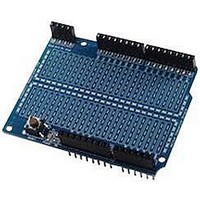AMICUS18-COMPANION-SHIELD AMICUS, AMICUS18-COMPANION-SHIELD Datasheet - Page 10

AMICUS18-COMPANION-SHIELD
Manufacturer Part Number
AMICUS18-COMPANION-SHIELD
Description
Amicus18 Companion Shield
Manufacturer
AMICUS
Datasheet
1.AMICUS18-COMPANION-SHIELD.pdf
(49 pages)
Specifications of AMICUS18-COMPANION-SHIELD
Silicon Manufacturer
Microchip
Core Architecture
PIC
Core Sub-architecture
PIC18
Features
USB Interface, In Circuit Serial Programming Interface
Kit Contents
Board
Silicon Family Name
PIC
Silicon Core Number
PIC18F25K20
Rohs Compliant
Yes
Lead Free Status / RoHS Status
Lead free / RoHS Compliant
For Use With
PIC18F25K20 Microcontroller
How to choose the resistor value
A resistor is a device designed to cause resistance to an electric current and therefore cause a drop in
voltage across its terminals. If you imagine a resistor to be like a water pipe that is a lot thinner than
the pipe connected to it. As the water (the electric current) comes into the resistor, the pipe gets thin-
ner and the current coming out of the other end is therefore reduced. We use resistors to decrease
voltage or current to other devices. The value of resistance is known as an Ohm and its symbol is a
Greek Omega symbol Ω.
In this case Digital Pin RB0 is outputting 3.3 volts DC at 25mA (milliamps), and our LED requires a volt-
age of 2v and a current of 20mA. We therefore need to put in a resistor that will reduce the 3.3 volts to
2.2 volts, and the current from 25mA to 20mA if we want to display the LED at its maximum brightness.
If we want the LED to be dimmer we could use a higher value of resistance.
To calculate what resistor we need to do this we use what is called “Ohms law” which is I = V/R where I
is current, V is voltage and R is resistance. Therefore to work out the resistance we arrange the formula
to be R = V/ I which is R = 1.1/0.02 which is 55 Ohms. V is 1.1 because we need the Voltage Drop,
which is the supply voltage (3.3 volts) minus the Forward Voltage (2.2 volts) of the LED (found in the
LED datasheet) which is 1.1 volts. We therefore need to find a 55Ω resistor. However, 55Ω resistors are
not easily found, so we’ll find a one close to it, 47 Ohms will do.
A resistor is too small to put writing onto that could be readable by most people so instead resistors use
a colour code. Around the resistor you will typically find 4 coloured bands and by using the colour code
in the chart on the next page you can find out the value of a resistor or what colour codes a particular
resistance will be.
Crownhill AssociatesLimited 2009 - All Rights Reserved
Colour
Black
Brown
Red
Orange
Yellow
Green
Blue
Violet
Grey
White
Gold
Silver
None
1st Band
0
1
2
3
4
5
6
7
8
9
Amicus18 Companion Shield
Version 1.0
2nd Band
0
1
2
3
4
5
6
7
8
9
3rd Band (multiplier)
x100
x101
x102
x103
x104
x105
x106
x107
x108
x109
x10-1
x10-2
9
4th Band (tolerance)
±1%
±2%
±0.5%
±0.25%
±0.1%
±0.05%
±5%
±10%
±20%
06-10-2009











